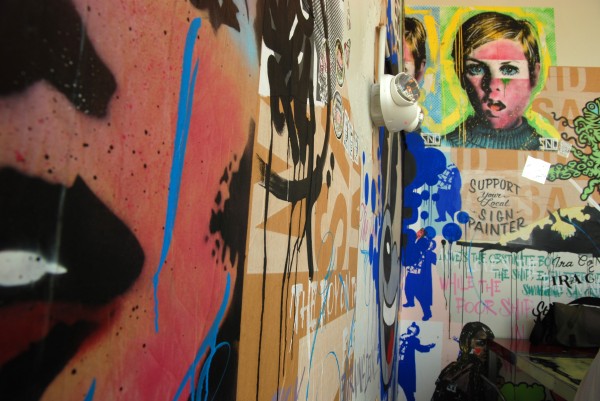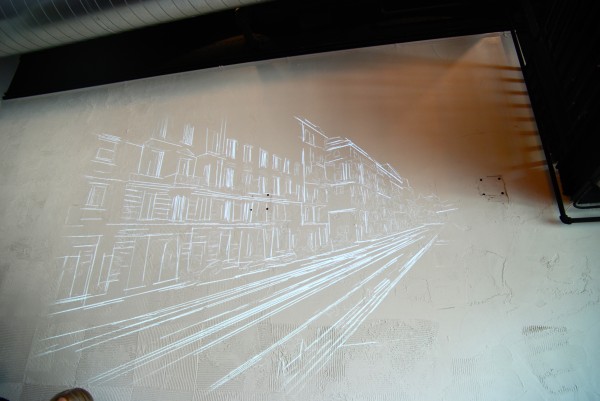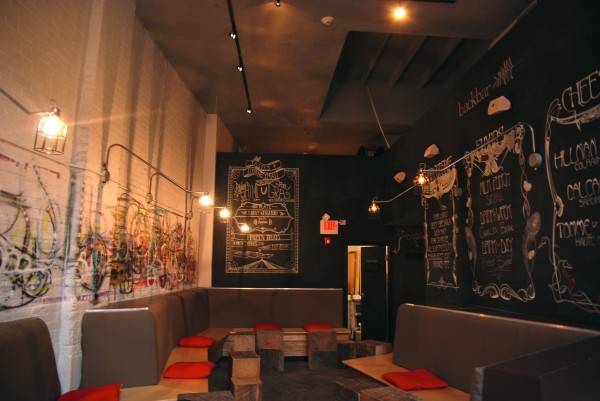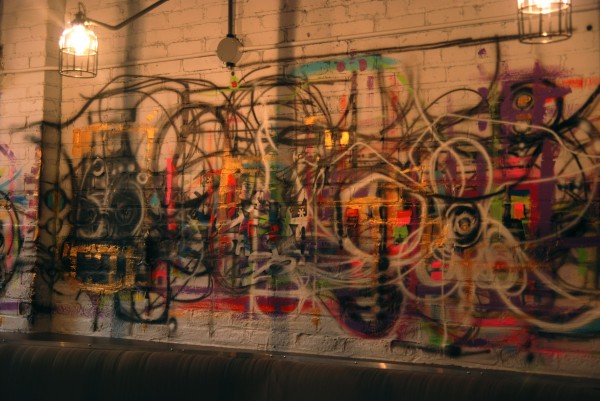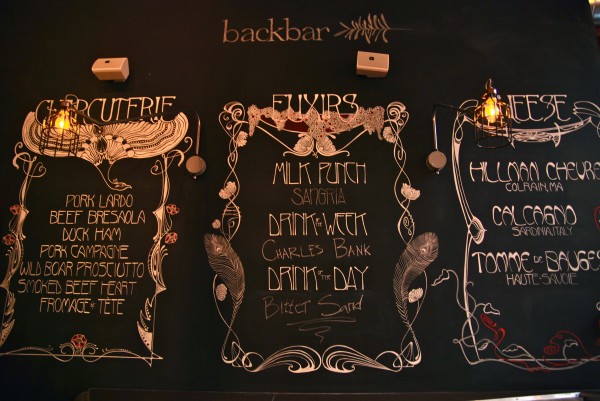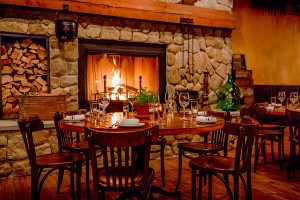Behind the Design: Graffiti, No Longer Just for Underpasses
 One of the graffiti-covered walls at Firebrand Saints in Kendall Square. All photos by Charlotte Wilder for Boston magazine.
One of the graffiti-covered walls at Firebrand Saints in Kendall Square. All photos by Charlotte Wilder for Boston magazine.
Street art isn’t just for the street anymore, as Boston restaurants are now sporting graffiti-adorned walls. I stopped by three of the restaurants behind the recent movement: Firebrand Saints in Cambridge’s Kendall Square, Backbar in Somerville’s Union Square, and the soon-to-open Happy’s Bar + Kitchen in Boston’s The Fenway, to find out what is is about this gritty style that has restaurateurs whipping out their spray cans (well, rounding up artists with their spray cans) and tagging their walls.
Firebrand Saints, Kendall Square:
“Part of the aesthetic we were going for was using the space as a palate,” says owner Gary Strack. “We weren’t interested in hanging people’s pictures up; we wanted to let artists come in and work.” Strack has always been a big proponent of street art; he has a legal wall in Central Square where anyone can tag the space as they like. But while work on the Central Square wall gets covered up quickly, the inside space at Firebrand Saints is a more curated, longer-lasting framework.
“We like people to work around other people’s work so it’s a collaborative piece,” Strack says. He adds, however, that if an artist “has better idea and wants to take the center, then they do that, and the person who was there before is gone. That’s the great thing about street art—it’s important and immediate, but it’s not permanent.”
The wall has been a runaway success: superstar graffiti artists from all over the country have lent their work to the space, such as Rene Gagnon, Kenji Nakayama, New York’s enigmatic Momo (who once tagged the width of Manhattan with a single line), Thom Buildmore from Philadelphia, Michael De Feo, and many more. As Strack says, it’s a “who’s who of graffiti artists.”
Hand-painted work isn’t the only art on view at Firebrand Saints. Near the entrance, a projector draws a picture onto a blank wall in twenty seconds, keeps it there for about thirty, and then repeats the process with a new image. Strack told me that the project, built by Theo Watson and Emily Gobeille of tech/design studio SoSolimited, “is a Google street view that’s updating live—essentially it’s picking a destination and drawing it on the wall.” This all happens in real time; the cars parked outside the restaurant that I saw when I walked in showed up in the projections. With this installation, Firebrand Saints is literally bringing the outside in, in a way that fits with Kendall Square’s high-tech vibe.
Backbar, Union Square:
Backbar, Journeyman restaurant’s adjacent bar sibling, has a wall with a similar a model to the one at Firebrand Saints. “My hope for this wall is to make it a rotating piece of art,” says bar manager Sam Treadway. “We’ll give the wall to different artists, and their work will stay for a few months or so; it’s a big blank canvas to play around with.”
The first artist to take over the “Backwall,” as Treadway calls it, is Josh Wisdumb, a graffiti and abstract artist who was invited to this year’s ArtBasel Show in Switzerland. Josh is hanging a few of his works on paper at Backbar this week as well, in order to compliment the work he did on the brick wall.
Josh isn’t the only one lending his talent to Backbar’s Backwall. Catherine Owens, a server at Journeyman, drew intricate chalkboard menus on the opposite wall. “This is starting a next chapter in her career,” says Treadway. “She saw I was trying to draw on the chalkboard one day, and was like, ‘Oh Sam, can I do that for you? ’cause you suck at it.'” Catherine started drawing the menu each day, and eventually decided to make a more definite rubric for the various offerings. Each panel took her about ten hours.
Chalk Art at Backbar from Catherine Owens on Vimeo.
“I don’t understand how viral videos work,” says Treadway, “but she made a time-lapse video [shown above] of her doing this chalkboard and got 45,000 views in one day.” Owens has since done boards at RJ’s Gourmet, a coffee-shop in East Cambridge, and is planning to do the board for the new Ball & Buck store on Newbury St.
Happy’s Bar + Kitchen, Fenway:
Michael Schlow’s new venture, Happy’s Bar + Kitchen, mixes whimsy and story-telling with its graffiti. When asked about the graffiti artists who tagged the walls of the new Fenway spot, Schlow says, “The story I’m telling everyone is, you know what? I never even met them. They came in in the middle of the night, marked up the walls, and I kept it.” He then, of course, told me the truth: the people who painted the space are local graffiti artists, who would prefer to remain anonymous (though, according to Thrillist today, they are affiliated with the high-end sneaker shop Bodega). “[The artists] were great to work with. I gave them very few directions other than I wanted a blue wall; they came up with the “Happy’s” stretching around the corner and everything else.”
To give his diner a culture and a theme, Schlow came up with a fictional backstory: that the Trilogy building (where Happy’s is located) had to be built around an old Boston bartender, Happy, and his establishment. Schlow tells it best: “Happy had been an old school bartender, and people kept marking up his walls. So finally he said, ‘You know what? It’s colorful, do what you want,’ and left the graffiti.”
The billboard hanging by the bar fits with Schlow’s vision; his fiancé came up with the idea, found one from 1951 from Seattle, and Schlow had it mounted on the wall.
Schlow’s favorite part of the entire space is the section of wall above. He says he loves how it pops, and how it contains last part of Happy’s name.
While I didn’t make it in there, Schlow told me that the men’s bathroom has the words “aim straight” stenciled over the urinals. “I want [the design] to be whimsical and funny without being gross or sophomoric,” he says. “For me, as a chef and a restaurateur, the creative process is what makes this so much fun. You have a vision, an idea, and you think it might work, but you never know. You just start to put pen to paper.”
While I can’t necessarily see graffiti becoming the standard in Boston (not quite sure how Rialto would look all tagged-up), it will be interesting to see if other restaurants follow suit. You never know, perhaps a gang of spray paint-weilding hooligans will break into Clio one night, and Ken Oringer will keep the aftermath.
For more online food coverage, find us on Twitter at @ChowderBoston.
